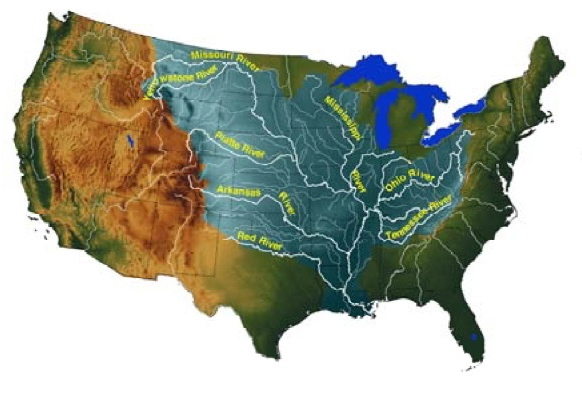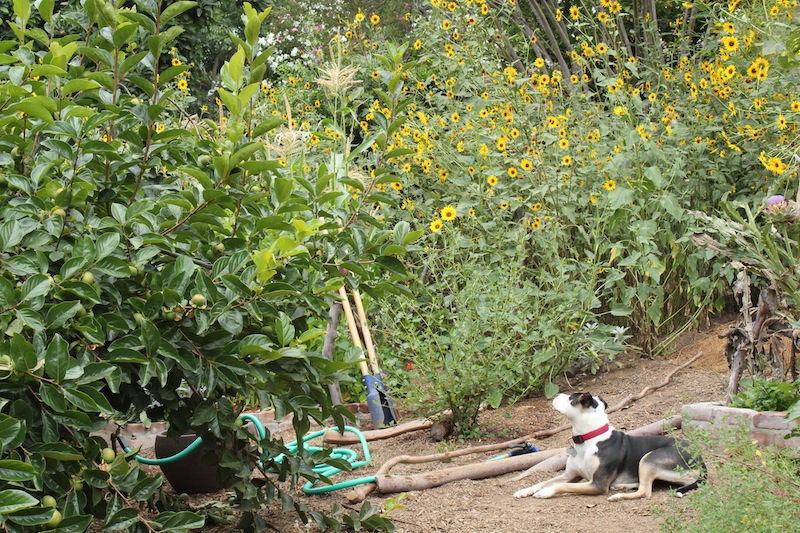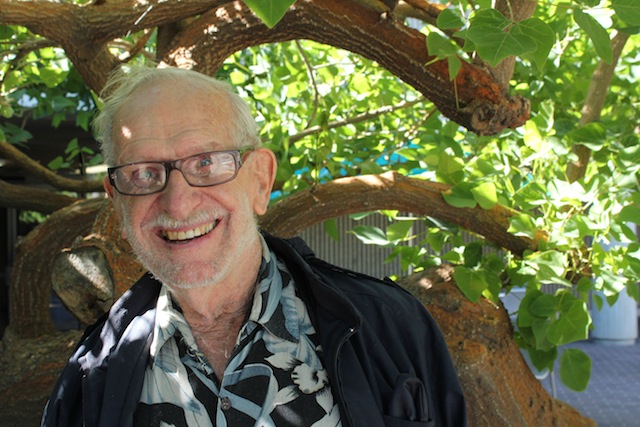High good, low bad: Mead in July 2011
Posted on | August 1, 2011 | 6 Comments

Why, you might wonder, would anyone in their right mind use a map highlighting the Mississippi River system for a monthly post about the elevation of the largest reservoir on the Colorado River? The reason is a renewed offer on the table from Las Vegas water manager Pat Mulroy. Divert the Mississippi and its tributaries to feed upper basin Colorado River users, give Vegas the water therefore left in the Colorado River system and she’ll leave the Great Basin aquifer alone. “The instate project wouldn’t be needed because at that point what you’ve done is securitize the Colorado River,” she tells a reporter for “Vegas, Inc.”
This transcontinental flood control scheme isn’t new. Pat’s been braving ribald mockery over it for at least three years now. The “give me more Colorado River water or the Great Basin desert gets it” line isn’t new either — that’s been a gambit since she applied for virtually all of the legally available groundwater around Great Basin National Park in 1989. What’s so much fun about this latest incarnation is the way it combines the drama of a hostage crisis with a seemingly lofty call to dream again in terms of Depression Era-style public works.
But saving the Great Basin desert from Vegas needn’t involve crossing the Continental Divide. Another way to achieve the same end might be for Vegas to strike a deal with the cash-strapped Metropolitan Water District of Southern California and Los Angeles Department of Water & Power.
Before laughing, and in normal times, the idea of a hog like California parting with water to help Nevada would be laughable, consider that LA and other Southern Californian cities served by Met are down on their uppers, skint, broke. Or as the Tom Cruise character’s normally shy girlfriend was reduced to shouting in the movie Jerry McGuire, “Broke, broke, broke!” The LADWP is so hard up for funds, it’s got a cart and pony show making the rounds trying to get voters to approve a rate increase to fix leaking water mains. They might as well be asking Tea Party imbeciles to tax billionaires. So California could use some Nevadan greenbacks. Nevada could definitely use some Californian water pooled up in Lake Mead.
Given that the maximum amount of water that the Nevada “instate project” — the pipeline running to the Great Basin National Park — would likely be allotted after hearings finish late this year is 200,000 acre feet per year, this idea’s not so crazy. The pipeline’s projected $2bn plus cost could repair a lot of aging water mains and pay for a lot of outdoor water conservation programs across So Cal. Why not strike a trade?
Oh, yes, Mead. The big drink on the Colorado River system closed July 31st, 2011 at 1,107.10 feet, almost five feet higher than the June closing thanks to a record Colorado snowpack. Click here for federal Bureau of Reclamation Mead elevations. That Mead is still less than half full should have us a lot more worried than we are, but the picture up and down the river is no longer utterly terrifying. Click here for a weekly report showing that the Colorado River system is 66% full this year as opposed to 58% last year.
The Dry Garden: Vertical meadow
Posted on | July 29, 2011 | No Comments

Jasmine Hawes and mother Ginny Hawes (background) kindly posed for scale in this summer's towering sunflower garden, planted as part of a conversion from lawn to a water efficient native garden.
There’s overdoing it, and there’s what I did. After sowing a pound of sunflower seeds last winter, eight months later, the phrase “height of summer” can now be taken literally. In lieu of a front hedge, I have sunflowers. One astounded woman even came to my door asking when and how to plant them. Neighbors call my home “the sunflower house.” Out back, my yard is a vertical meadow.
Click here to keep reading “The Dry Garden” in the Los Angeles Times on how wildflowers can serve as a succession crop when replacing lawn.
Click here to see what’s doing at the Theodore Payne Foundation for Wildflowers and Native Plants, and here for our regional treasure, the Rancho Santa Ana Botanic Garden. If you haven’t been to Rancho, go. There is no other public garden in the state that does a better job displaying our native flora in ways easily and relatively cheaply adaptable by home-owners in search of alternatives to lawn. Think of a year without leaf blowers and lawn mowers. Think of the hummingbirds. Think of your wallet. Finally, for the best round-up of regional garden classes, don’t miss Lisa Boone’s weekly datebook column at the Los Angeles Times.
The Dry Garden: Summer dormancy
Posted on | July 15, 2011 | 2 Comments
 Emily Green, that would be me, is on vacation (read thinning the persimmon tree so the wood doesn’t give way under the weight of a bumper crop), but click here for ten LA Times Dry Garden columns about what to do while a garden enters summer dormancy.
Emily Green, that would be me, is on vacation (read thinning the persimmon tree so the wood doesn’t give way under the weight of a bumper crop), but click here for ten LA Times Dry Garden columns about what to do while a garden enters summer dormancy.
The Dry Garden: North East Trees
Posted on | July 8, 2011 | 1 Comment
 Unless you are active in the field of urban greening, you probably haven’t heard of North East Trees. Unlike the better known TreePeople, North East Trees has not seen its founder land on “The Tonight Show.” Rather, the nonprofit that Scott Wilson started in 1989 by planting 700 oaks at Occidental College in Los Angeles’ community of Eagle Rock has quietly been planting many more trees (50,000 at last count), working with low-income communities to create parks, and partnering with city and county agencies on water-harvesting projects. North East Trees has been at the cutting edge of L.A.’s ecological makeover.
Unless you are active in the field of urban greening, you probably haven’t heard of North East Trees. Unlike the better known TreePeople, North East Trees has not seen its founder land on “The Tonight Show.” Rather, the nonprofit that Scott Wilson started in 1989 by planting 700 oaks at Occidental College in Los Angeles’ community of Eagle Rock has quietly been planting many more trees (50,000 at last count), working with low-income communities to create parks, and partnering with city and county agencies on water-harvesting projects. North East Trees has been at the cutting edge of L.A.’s ecological makeover.
Click here to keep reading about North East Trees in this week’s Dry Garden column in the Los Angeles Times.
High good, low bad: Mead in June 2011
Posted on | July 6, 2011 | 1 Comment

Source: Water Resource Planning in Washington County, Utah and the Lake Powell Pipeline, Presented at the Nevada Water Resource Association meeting February 3, 2011 by Corey Cram of the Washington County Water Conservancy District
Not only is this normally first-of-the-month post about Lake Mead late, it’s not even about Lake Mead. I find that the other great storage reservoir on the Colorado River, Lake Powell, was the more interesting of the big drinks in June. The Salt Lake Tribune found Utah’s Department of Water Resources taking state legislators for a plane ride over Utahn water ways. Whee.
Unlike leaner years, there was plenty of gleaming snowpack to sell any number of projects, not least the patently crazy proposal for a $1.1bn pipeline from Lake Powell into the snowbird communities of Washington County. That stretch of old Mormondom is to the south of the state, along the border of Nevada’s dry Lincoln County. This is where the Mojave Desert extends into Utah, a place called “Dixie” by the locals, where they only gamble, drink or smoke during trips to nearby Vegas.
Not long ago, a big business here was in ghost town tours. Now it’s in building retirement housing. The ultimate objective of the Lake Powell pipeline is to further populate the Mojave on the back of an already disastrously over-allocated Colorado River. Not all the local folks love the plan. I hadn’t heard of Citizens for Dixie’s Future until just landing on their website, but I like their catch phrases for the pipeline: “expensive,” “unreliable,” “unnecessary,” and “sprawling.”
Why would anyone tap the Colorado river more deeply when everyone agrees that it’s already crazily over-allocated? Because Utah is legally entitled to do it, and its developers are as greedy as our developers. Unlike our developers, they actually have legal claim to as yet un-used water. Unable traditionally to truck their water long distances, the “upper” Colorado River basin states such as Utah, Colorado, Wyoming and New Mexico have often been forced to see it released down stream for use by “lower” basin states of California, Nevada and Arizona, along with Mexico and, heavens forfend, fish. Phoenix, San Diego and LA all owe much to these surpluses. The Lake Powell pipeline would pull another 100,000 acre feet of water from the Colorado River, most of which would go to desert retirement communities such as St George.
If you’re wondering if more for them means less for us, the answer is yes.
The other Whoa, Nellie point, made almost en passant in the Tribune piece, refers to pending Utah legislation to buy sleeping Navajo rights for 81,500 acre-feet of Colorado River water. That is enough for 160,000 homes. Make that 80,000 in Utah, a state whose residents Vegas Water Manager Pat Mulroy rightly describes as being unable to spell “conservation.” This is fascinating because, again, the river is gaining abusive users while, for the most part, the amount of water in it is declining. Here, a product of brief surfing, is an article on the subject from the Navajo Times. Interested persons could spend a lot of time searching “water rights” at this newspaper. What all this means, I don’t know, other than less water in the river.
On that note, click here for the closing elevation of Lake Mead.
Tags: Emily Green > Lake Mead > Lake Powell Pipeline > Washington County Utah


